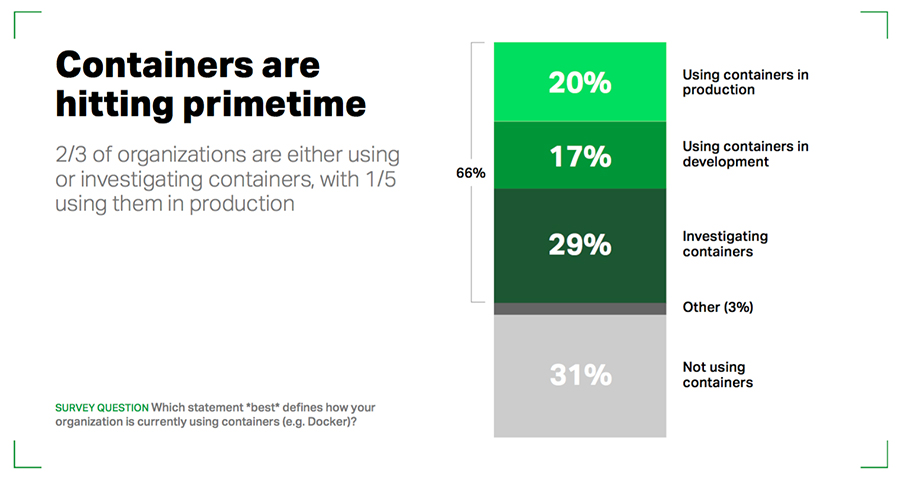 NEWS
NEWS
 NEWS
NEWS
 NEWS
NEWS
The drive for innovative, modern applications has changed the state of application development and deployment. Relatively new technologies have become mainstream, and developers are leading the charge when it comes implementing them in companies.
According to a study by NGINX Inc. on the future of application development, 74 percent of the 1,800 IT professionals surveyed said developers are responsible for choosing application development and delivery tools.
Developers are taking charge and gaining more decision-making powers, said Peter Guagenti, chief marketing officer at NGINX. And the technologies they’re choosing to implement are containers, such as Docker, and microservices.
The study found two-thirds of organizations are using containers or investigating using them. And of the organizations using containers, half are using them for mission-critical applications.
Similarly, microservices are being adopted rapidly and entering the mainstream, Guagenti said. Nearly 70 percent said they are using or investigating microservices. Of those using them, almost 30 percent said they use them production, and 15 percent said they use them in development.
“We went into the study thinking a lot of the things developers are excited about—containers, microservices, cloud, DevOps, continuous delivery—were still in the hype cycle. We thought we’d see some use of them, but it wouldn’t be dramatic. So, we were surprised to see such a large number using them,” he said.
Other technologies rising in use include continuous integration and development, orchestration and automation tools, self-managed distributed systems and global load balancing.
This rapid adoption of a technology hasn’t been seen in a while, he said. It could be due, in part, to the pressure on IT teams from the business side to accelerate the pace of innovation. A lot of teams are being judged on how fast they can develop and deploy applications, so developers have sought out the best technologies to help them do that.
In fact, it appears that it’s the challenger brands—companies that are really trying to differentiate themselves from their competitors—that are using these technologies more than other companies, Guagenti said.
“With microservices, is all about velocity. It’s about innovation. It’s about being able to move fast and break things and make better product for it,” he said. “So, it’s no surprise that those that are in a position to invest in technology and are trying to overcome a competitor are the ones who are using [new technologies] the most.”
Guagenti said, however, that all companies should be looking into new technologies. If they don’t, they risk falling behind.
“In technology, the act of not moving does not mean you are staying static. It actually means you are in degradation. And that’s something most people don’t really fully appreciate,” he said.
Also, if companies are stuck on old technology and their applications are out of date, they end up spending more time maintaining those systems than they’re worth, he said. They will also have trouble attracting workers who can help move the company forward.
“Old technology eventually becomes a boat anchor,” Guagenti said. “If you are not looking at your business and saying, ‘how do I keep moving this stuff forward,’ somebody else is looking into how to do it to take you out of business.”
Survey respondents overwhelmingly prefer public cloud over private cloud. Nearly every respondent said they use public cloud services. And the public cloud provider that they said is the best: Amazon Web Services (AWS). Nearly 50 percent said they believe AWS is the best public cloud service. Fourteen percent said Google Cloud Platform, 8 percent said Microsoft Azure and 6 percent said other providers.
The popularity of AWS was even more pronounced at medium and large companies, where 75 percent of respondents said AWS is the best cloud service.
Guagenti said three things contribute to AWS’ dominance. First, the company has the “first-person advantage.” It was the first cloud service provider, it’s been around for several years and people know about them. Second, their APIs are mature. Third, AWS has an extensive and mature ecosystem of technology companies and partners.
Application performance, uptime and security are more important to organizations than innovation and adding new features, according to the study. Over 75 percent said performance is an issue for them, and 25 percent said their applications are slow.
Despite that, few dedicate time and resources to address performance issues.
“This is remarkable because performance is one of those things that has a direct bottom-line dollar impact” on a company, Guagenti said. “So, you’d think people would be obsessive about performance because it’s so easy for customers to switch over to a competitor. But people are just plugging their ears and hoping for the best.”
Organizations also may not know how to fix the code to improve the performance of their application, he said. Or they may not have the time and resources because they’re trying to add new features.
Regardless, organizations need to pay attention to and address performance issues—improve the code or use front-end tools—or risk losing customers, Guagenti said.
Support our mission to keep content open and free by engaging with theCUBE community. Join theCUBE’s Alumni Trust Network, where technology leaders connect, share intelligence and create opportunities.
Founded by tech visionaries John Furrier and Dave Vellante, SiliconANGLE Media has built a dynamic ecosystem of industry-leading digital media brands that reach 15+ million elite tech professionals. Our new proprietary theCUBE AI Video Cloud is breaking ground in audience interaction, leveraging theCUBEai.com neural network to help technology companies make data-driven decisions and stay at the forefront of industry conversations.